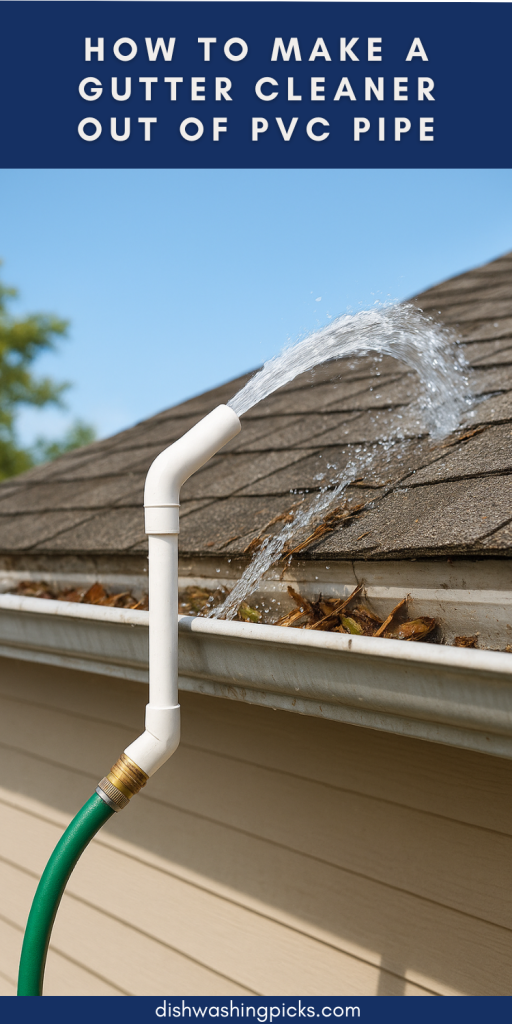
The Problem We All Dread
Let’s be honest—nobody wakes up on a Saturday morning excited to clean their gutters. It’s messy, it’s awkward, and let’s not even talk about how nerve-wracking it feels balancing on a ladder while trying not to fall into the bushes below. Sound familiar?
Now, imagine if you could stay safely on the ground while blasting out all those soggy leaves and pine needles with ease. Good news—you actually can. All you need is a little creativity, a length of PVC pipe, and a willingness to do some simple DIY.
Stick with me, and by the end of this, you’ll have your very own homemade gutter cleaner, minus the ladder drama.
Why PVC Pipe?
You might be wondering, “Why PVC? Why not just buy one of those fancy gutter cleaning tools?” Fair question.
Here’s the thing: PVC pipe is:
- Cheap – A few dollars at your local hardware store.
- Lightweight – You can easily maneuver it without breaking a sweat.
- Customizable – Cut it, bend it, or extend it however you need.
In short, it’s the DIY-er’s dream material. Plus, there’s something satisfying about taking a simple piece of pipe and turning it into a tool that saves you both time and money.
What You’ll Need (Don’t Worry, It’s Simple)
Grab these supplies before we start tinkering:
- A length of PVC pipe (1–1.5 inches in diameter works great)
- A couple of PVC elbow joints (to create the curve for the gutter)
- A hacksaw (for cutting)
- PVC cement or strong adhesive (optional, for securing joints)
- A garden hose with a spray nozzle
That’s it. Nothing fancy. You probably already have half of these things lying around the garage.
Step 1: Cutting and Connecting the Pipe
Here’s where the fun begins.
- Measure your height + gutter height. You want your PVC pipe long enough to reach up there comfortably while you stay on the ground. For most homes, around 10–12 feet should do the trick.
- Cut the pipe. Use your hacksaw to cut it into manageable sections (think 4–6 feet each).
- Attach the elbows. At the top end of your pipe, connect two PVC elbow joints to create a hook shape. This is what will let you aim water right into the gutter.
Pro tip: Dry fit everything first before gluing. Once the PVC cement goes on, there’s no turning back!
Step 2: Hooking Up the Hose
What’s a gutter cleaner without water pressure?
- On the bottom end of your PVC pipe, attach your garden hose. You can do this with a threaded PVC adapter (found at any hardware store).
- If you don’t have an adapter, no worries—duct tape is surprisingly effective here. Just wrap it tight and secure.
- Turn on the water and test it. You should get a decent stream shooting out of the hooked end.
Imagine this: you’re standing on the ground, pointing your homemade PVC wand, and blasting away leaves like a pro. No ladder, no sweat, no problem.
Step 3: Cleaning Time
Now for the satisfying part.
- Position the hooked end over the gutter.
- Turn on the water and slowly move along the length of your gutter.
- Watch as years of soggy leaves, twigs, and who-knows-what-else get flushed away.
You’ll probably need to walk around the house a few times, but it beats climbing up and down a ladder a hundred times, right?
Extra Tips to Make Life Easier
- Add a handle. Wrap the bottom with some foam or tape for comfort.
- Make it modular. Leave your PVC in sections so you can add/remove pieces depending on gutter height.
- Control water pressure. If your hose has a nozzle with different settings, experiment to find what works best.
Oh, and one more thing—don’t forget to wear old clothes. This project tends to get a little splashy.
Wrapping It Up
There you have it: your very own DIY gutter cleaner made from PVC pipe. Simple, cheap, and effective. Sure, you could spend $50+ on a store-bought gadget, but where’s the fun in that?
Next time someone complains about how awful gutter cleaning is, you can casually say, “Oh, I just made my own tool for that.” Instant bragging rights.
So, what do you think—ready to head to the hardware store and grab some pipe? Your gutters (and your Saturday mornings) will thank you.
